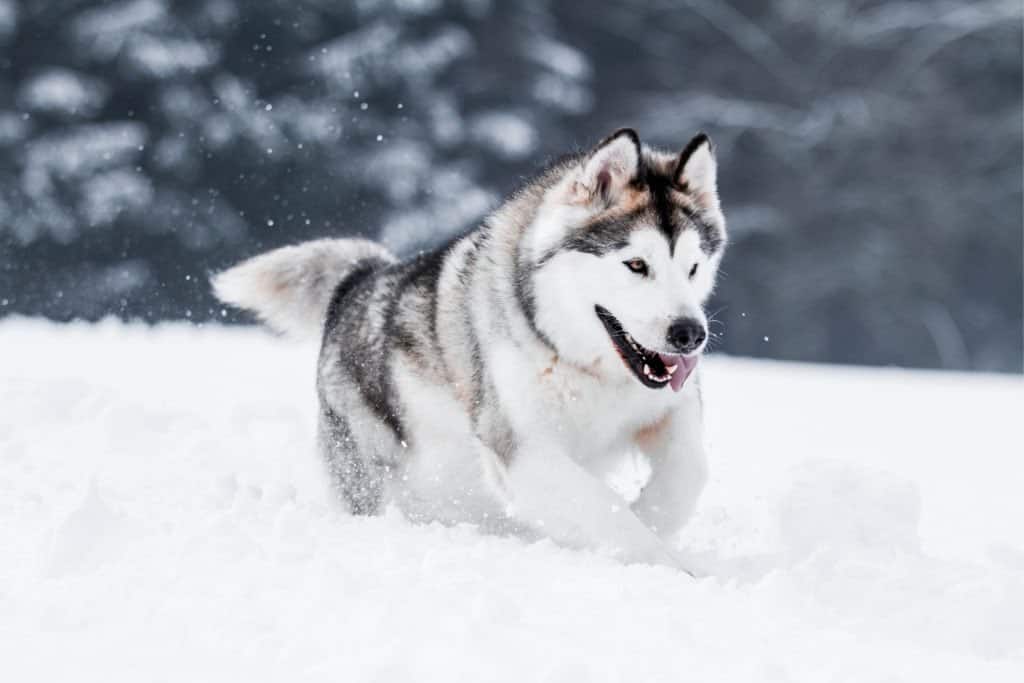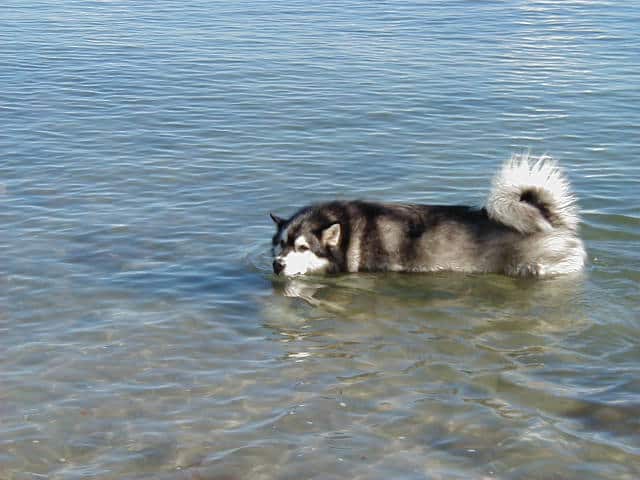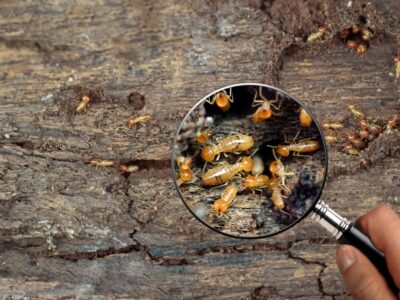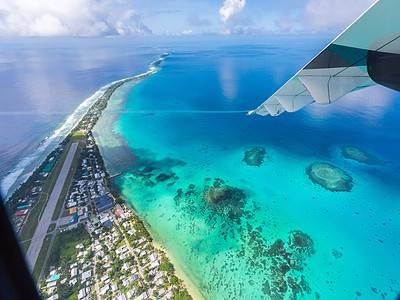Often used as sled dogs!
Advertisement
Alaskan Malamute Scientific Classification
- Kingdom
- Animalia
- Phylum
- Chordata
- Class
- Mammalia
- Order
- Carnivora
- Family
- Canidae
- Genus
- Canis
- Scientific Name
- Canis Lupus
Read our Complete Guide to Classification of Animals.
Alaskan Malamute Conservation Status
Alaskan Malamute Facts
- Distinctive Feature
- Pointed face and upturned tail
- Temperament
- Affectionate, friendly and loyal
- Training
- Medium
- Diet
- Omnivore
- Average Litter Size
- 6
Alaskan Malamute as a Pet:
- General Health
- Energy Level
- Shedability
- Trainability
- Intelligence
- Tendency to Chew
- Size
- Family and kid friendliness
- Yappiness / Barking
- Moderate
- Separation Anxiety
- Low
- Preferred Temperature
- Cold climate
- Exercise Needs
- High
- Friendly With Other Dogs
- Group
- Pure bred cost to own
- $500 to $2,500
- Dog group
- Working
- Male weight
- 75-85 lbs
- Female weight
- 65-75 lbs
This post may contain affiliate links to our partners like Chewy, Amazon, and others. Purchasing through these helps us further the A-Z Animals mission to educate about the world's species.
View all of the Alaskan Malamute images!

Alaskan malamutes are highly intelligent and social dogs. They’re energetic and highly affectionate.
The Alaskan malamute is a member of the spitz family of dog breeds and was bred by the Inuit people to pull their sleds. They have a similar appearance to the Siberian husky, but when they stand side by side, the giant, fluffy malamute dwarfs the husky.
See all of our expert product reviews.
This breed is friendly, intelligent, and full of energy, which makes them the perfect pet for an active family. They do have a bit of a stubborn streak, however, so owners need to establish themselves as a leader right from the start with gentle but consistent training.
Alaskan malamutes love spending their time around people, including strangers, so they don’t make good guard dogs. Their high energy and need for near-constant attention can make caring for a malamute a bit of a handful, but with time and patience, this breed will make a wonderful companion for people of all ages.
3 Pros and Cons of Owning an Alaskan Malamute

©Carina Wicke Photographer, CC BY-SA 3.0, via Wikimedia Commons – License
| Pros! | Cons! |
| Extremely intelligent Alaskan malamutes are highly intelligent dogs. You can begin training your new puppy as soon as you bring him home because even at a young age, this breed can pick up on your training cues. | Stubbornness makes training difficult Due in part to their high level of intelligence, Alaskan malamutes tend to be stubborn. They can learn the rules quickly and easily, but without consistent training, they will also find all sorts of ways to break those rules. |
| Energetic and playful This breed is full of energy and always enjoys playing with his master. This quality makes the Alaskan malamute a fantastic family dog. | Needs plenty of exercises Alaskan malamutes were bred as working dogs, and as such, their energy levels are through the roof. Vets recommend a minimum of two hours of exercise each day to keep pent-up energy from leading to bad habits. |
| Highly affectionate These dogs love nothing more than curling up with their families after a long day of working or playing. | Excessive shedding This breed sheds a fair amount all year round and has a blowout of his seasonal coat twice a year. You’ll need to brush your malamute 2 to 3 times a week between blowouts and once every day during shedding season to keep from swimming in dog hair. |
Evolution and Origins
The Alaskan Malamute is one of the largest breeds of domestic dogs that originated in the Arctic region of Alaska. They were bred by the Mahlemut Inuit people as heavy freighting sled dogs and were used for hunting and hauling heavy loads over long distances in harsh, arctic conditions.
The breed’s origins can be traced back to the Mahlemut people of Alaska, who developed the Alaskan Malamute over thousands of years by selectively breeding dogs with the strongest working abilities. These early Malamutes were used for a variety of tasks, including hauling heavy loads, hunting, and guarding the village.
Health and Entertainment for your Alaskan Malamute
See all of our expert product reviews.
During the gold rush of the late 1800s, the Alaskan Malamute was used by prospectors to pull sleds loaded with supplies and equipment. The breed’s popularity grew as more people began to recognize their strength, endurance, and loyalty.
In the early 20th century, the Alaskan Malamute was recognized as a breed by the American Kennel Club. Today, the Alaskan Malamute is still used for sledding, carting, and weight pulling but also as a family companion.
It is considered one of the oldest Arctic sled dog breeds and is one of the three breeds of the Alaskan sled dog, the other two being the Siberian Husky and the Samoyed.
Appearance

©Aneta Jungerova/Shutterstock.com
Alaskan malamutes are sturdy, muscular dogs whose breed was created for sled pulling. They have dark, medium-sized eyes and small triangular ears. The most striking feature of this breed is the distinctive markings on their faces, which are mostly white with a colored bar or mask near the eyes.
Their thick fur comes in a variety of colors, like black and white, grey and white, or red and white, and their beautiful, fluffy tails curl gently over their backs.
Alaskan Malamute Size and Weight
Alaskan malamutes are large working dogs. They weigh between 75 and 100 pounds and stand between 23 and 25 inches tall at the shoulder. The males of this breed tend to be a bit larger than the females.
Alaskan Malamute vs. Siberian Husky
The most striking difference in appearance between malamutes and huskies is their size, with the malamute being much larger than the husky. Huskies have smaller heads, and their ears are closer together than the malamute.
They are also well-known for their bright blue eyes, whereas malamutes, like most other breeds, have brown eyes. Both breeds have a variety of fur colors, such as black, grey, or red markings on white bodies, but only the Siberian husky can have agouti coloring.
Common Health Issues

©Mythliss/Shutterstock.com
Like many other large breeds, Alaskan malamutes often fall victim to hip and elbow dysplasia. They are also prone to clotting issues due to a hereditary condition called thrombopathia. Inherited polyneuropathy is another hereditary disease that breeders should screen for in their breeding animals.
This disease can cause limb and facial paralysis, spatial disorientation, and slowed heartbeat. Malamutes may also face health issues like chondrodysplasia (dwarfism), hypothyroidism, day blindness, and von Willebrand’s disease.
As with any purebred animal, the key to reducing these complications is responsible breeding. Make sure your new pup comes from a reputable breeder, and have him evaluated by a veterinarian to make sure he has a clean bill of health.
In summary, the biggest health threats to the Alaskan malamute are:
- Inherited polyneuropathy
- Hip dysplasia
- Chondrodysplasia
- Hypothyroidism
- Day blindness
- von Willebrand’s disease
Temperament

An Alaskan Malamute In Water
©No machine-readable author provided. Daniel Piil~commonswiki assumed (based on copyright claims)., CC BY-SA 3.0, via Wikimedia Commons – License
Alaskan malamutes are friendly, intelligent, and energetic. This breed won’t make a good guard dog; he would rather befriend strangers than defend his home against them.
Although the malamute was bred as a pack dog, he is just as content with his human pack as he is with other dogs. Unlike the other breeds in the spitz family, malamutes are fairly quiet dogs. They will “talk” to their owners and let lose the occasional howl, but they aren’t nuisance barkers.
Alaskan malamutes have a strong prey drive, so they aren’t suitable for households with small animals. They also need to be secured at all times; even well-trained malamutes may run from their masters if the mood strikes them.
The Best Dog Food for Alaskan Malamutes
Alaskan malamutes have no particular dietary concerns and should be able to stay healthy on high-quality dog food. As with any breed, make sure you feed your malamute according to his healthy weight maintenance requirements, taking care to include his treats when calculating his daily caloric intake.
If your Alaskan Malamute’s shedding is becoming excessive, there are some dog foods that can help manage to shed.
Otherwise, you want extremely high-quality, nutrient-dense dog food for your Malamute to keep it full, energetic, and at a healthy weight.
At A-Z Animals, we suggest feeding Alaskan Malamutes Purina Pro Plan Large Breed & Giant Breed Chicken & Rice Adult Dry Dog Food & Wet Dog Food.
This large breed dog food is loaded with important calcium, phosphorus, and glucosamine, to keep Alaskan Malamute’s joints pain-free and mobile, so your dog will be light on its feet for many years. There’s copper, zinc, vitamin D3, B vitamins, and more for head-to-toe health. Since this recipe has lots of chicken, beef, and egg, it’ll give your Alaskan Malamute enough protein to build and keep lean muscle
See if your Alaskan Malamute likes Purina Pro Plan Large and Giant Breed Dog Food, available on Chewy or Amazon.
- Crunchy kibble combined with tender, shredded pieces for taste and texture dogs love
- High protein formula, with real chicken as the first ingredient
- Fortified with guaranteed live probiotics for digestive and immune health
- Used to be known as SAVOR Shredded Blend Large Breed Formula
- Glucosamine and EPA, an omega-3 fatty acid, for joint health and mobility
Best Insurance
Like other large dog breeds, Alaskan malamutes are susceptible to hip dysplasia, and their purebred status leaves them at risk of several hereditary disorders, so it’s important to find an insurance company that will cover these types of conditions. As such, it’s a good idea to get comprehensive pet insurance when you bring them home. The younger they are, the less likely they will be to have pre-existing conditions that could disqualify them from coverage.
Maintenance And Grooming
Alaskan malamutes are fairly low-maintenance dogs. They don’t have a strong odor and only need bathing every 6 to 8 weeks. Their coats don’t need any special trimming, but they do need brushing a few times a week to cut down on hair fall. These dogs shed all year round and go through a blowing season twice a year. During the blowing period, you will need to brush your pup every day to keep hair from building up around the house.
Beyond coat care, their maintenance routine is simple. All you need to do is brush their teeth and clean their ears often, and trim their nails each month to keep your Malamute happy and healthy.
Training
You should start training your malamute puppy as soon as you bring him home. He is very bright and will pick up on your commands quickly. Due to their intellect, these dogs can be quite stubborn, so owners need to establish themselves as leaders right from the start. Without proper training, your malamute will own you rather than the other way around. Consider enrolling your pup in obedience classes to help him develop a calm personality.
Exercise
With the origins of a working dog, this breed has endless stores of energy. Vets recommend a minimum of two hours of exercise daily to keep your malamute in a generally relaxed state. Without a proper outlet for his energy, he will turn to destructive behaviors to occupy his time.
Puppies
Before you bring home your Alaskan malamute puppy, you should puppy-proof your home. This breed is notoriously destructive when bored or full of energy, and puppies fit both of these categories frequently.
To release some of his energy as a young puppy, you’ll need to get safe toys for your malamute to play with. He will also need a safe space to sleep; as such, crate training is highly recommended.
Since this breed is highly intelligent, training can begin as soon as you bring your new pup home. At 8 to 9 weeks, he can begin to learn basic commands such as sitting and staying in a controlled environment. This light but consistent training will help you form a bond with your new puppy and show him right from the start that you are his leader.
As soon as he is old enough to have the required vaccinations, you should consider enrolling your pup in puppy kindergarten to help with proper socialization and obedience training.

©Zuzule/Shutterstock.com
Alaskan Malamutes And Children
Due to their friendliness, playfulness, and affectionate nature, Alaskan malamutes get along wonderfully with children. As such, they make fantastic family dogs. As with any large breed, it’s important to teach both dog and child how they can safely interact with each other. Remember, no matter how well-behaved your dog is, to prevent accidental injuries, you should never leave them unsupervised with children.
Dogs Similar to the Alaskan Malamute
A few breeds that are similar to Alaskan Malamutes are:
- Siberian Husky: Siberian huskies are a bit smaller than Alaskan malamutes but have a similar appearance and nearly the same temperament.
- American Eskimo Dog: American Eskimo dogs share the Alaskan malamute’s friendly disposition but are smaller in size. This breed comes in a variety of sizes, from the toy, which stands about 9 inches tall at the shoulder, to the standard, which stands about 19 inches tall.
- Chinook: The Chinook is a bit smaller than the Alaskan malamute, but it has all the same great personality traits that make these breeds excellent family dogs.
Popular Names
A few of the most popular names for Alaskan malamutes are:
- Zeus
- Bear
- Max
- Odin
- Ghost
- Nova
- Maya
- Kuma
- Echo
- Freyja
Alaskan Malamute FAQs (Frequently Asked Questions)
What is an Alaskan malamute?
Alaskan malamutes are working dogs that originated in Alaska, where the Inuit people bred them to pull heavy loads on their sleds. They are similar in appearance to the Siberian husky, but a side-by-side comparison will quickly show onlookers that the giant, fluffy malamute dwarfs the medium-sized husky. Due to this difference in size, malamutes were bred for endurance rather than speed; it was their job to pull heavier loads over a longer period.
How much does an Alaskan malamute cost?
The cost of an Alaskan malamute depends on the breeder and can range anywhere from $500 to $2,500 depending on pedigree. If you’d rather get your malamute from a rescue, you can expect to pay between $200 and $400 in rehoming fees.
Are Alaskan malamutes dangerous?
Although Alaskan malamutes often end up on the list with the most dangerous dog breeds, this is due to a misunderstanding of the breed. It is a large breed, and it has a hulking appearance, so its exuberance is often mistaken for aggression. Malamutes do have a strong prey drive and shouldn’t live with smaller animals, but they love humans and are nearly always quite friendly with people of all ages.
What is the difference between a Siberian husky and an Alaskan malamute?
The main difference between huskies and malamutes is their size. On average, malamutes are quite a bit bigger and stronger than huskies. Malamutes also tend to be more affectionate with their human families and get along just fine in only-dog households, whereas huskies prefer to have at least one other dog in their pack.
How big do Alaskan malamutes get?
Alaskan malamutes weigh about 75 to 100 pounds and stand between 23 and 25 inches tall at the shoulder. The males of this breed are slightly larger than the females.
Are Alaskan Malamutes herbivores, carnivores, or omnivores?
Alaskan Malamutes are Omnivores, meaning they eat both plants and other animals.
What Kingdom do Alaskan Malamutes belong to?
Alaskan Malamutes belong to the Kingdom Animalia.
What class do Alaskan Malamutes belong to?
Alaskan Malamutes belong to the class Mammalia.
What phylum to Alaskan Malamutes belong to?
Alaskan Malamutes belong to the phylum Chordata.
What family do Alaskan Malamutes belong to?
Alaskan Malamutes belong to the family Canidae.
What order do Alaskan Malamutes belong to?
Alaskan Malamutes belong to the order Carnivora.
What type of covering do Alaskan Malamutes have?
Alaskan Malamutes are covered in Hair.
What genus do Alaskan Malamutes belong to?
Alaskan Malamutes belong to the genus Canis.
What are some distinguishing features of Alaskan Malamutes?
Alaskan Malamutes have pointed faces and upturned tails.
How many babies do Alaskan Malamutes have?
The average number of babies an Alaskan Malamute has is 6.
What is an interesting fact about Alaskan Malamutes?
Alaskan Malamutes are often used as sled dogs!
What is the scientific name for the Alaskan Malamute?
The scientific name for the Alaskan Malamute is Canis Lupus.
What's the difference between Alaskan Malamutes and Samoyeds?
Samoyeds are smaller than Alaskan Malamutes, despite both of them being sled dogs. Read all about their other differences here!
What are the differences between the Alaskan Malamute and the Siberian Husky?
The major differences between the Alaskan Malamute and the Husky are found in their size and lifespan.
Thank you for reading! Have some feedback for us? Contact the AZ Animals editorial team.
Sources
- DogTime, Available here: https://dogtime.com/dog-breeds/alaskan-malamute#/slide/1
- O'Mal Malamutes, Available here: https://omalmalamutes.com/omal/pupdevelopment.htm
- Vet Street, Available here: http://www.vetstreet.com/dogs/alaskan-malamute#personality
- American Kennel Club, Available here: https://www.akc.org/dog-breeds/alaskan-malamute/
- Embrace Pet Insurance, Available here: https://www.embracepetinsurance.com/dog-breeds/alaskan-malamute
- PetMD, Available here: https://www.petmd.com/dog/conditions/neurological/c_multi_peripheral_neuropathies
- PerfectDogBreeds.com, Available here: https://www.perfectdogbreeds.com/malamute-vs-husky/#:~:text=A%20Husky%20will%20be%20loyal,are%20lighter%20yet%20faster%20dogs.&text=Husky%20tend%20to%20live%20longer,when%20compared%20to%20a%20Malamute.
- Hello Bark, Available here: https://hellobark.com/advice/alaskan-malamutes-pros-and-cons/#Cons



















